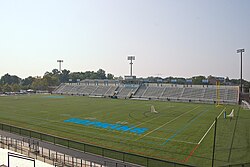Homewood Field: Difference between revisions
Hcoder3104 (talk | contribs) No edit summary Tags: Mobile edit Mobile web edit Advanced mobile edit |
GreenC bot (talk | contribs) Rescued 1 archive link; remove 1 link. Wayback Medic 2.5 per WP:URLREQ#sportsillustrated.cnn.com |
||
| Line 26: | Line 26: | ||
It was also the home field for the professional lacrosse team, the [[Baltimore Bayhawks]], for the 2001 and 2003 [[Major League Lacrosse]] seasons. It hosted the Division I [[NCAA Men's Lacrosse Championship]] in 1975, and was the site for the 2016 Big Ten men's lacrosse tournament. The south grandstand is named for Conrad Gebelein (1884–1981), longtime music director at the university. |
It was also the home field for the professional lacrosse team, the [[Baltimore Bayhawks]], for the 2001 and 2003 [[Major League Lacrosse]] seasons. It hosted the Division I [[NCAA Men's Lacrosse Championship]] in 1975, and was the site for the 2016 Big Ten men's lacrosse tournament. The south grandstand is named for Conrad Gebelein (1884–1981), longtime music director at the university. |
||
While known primarily for being the "[[Yankee Stadium]] of Lacrosse",<ref>[http://media.www.jhunewsletter.com/media/storage/paper932/news/2007/03/01/LacrosseGuide/The-Exalted.History.Of.The.Hopkins.Lacrosse.Program-2755384.shtml The exalted history of the Hopkins lacrosse program], ''[[The Johns Hopkins News-Letter]]'', March 1, 2007. {{webarchive |url=https://web.archive.org/web/20070507130831/http://media.www.jhunewsletter.com/media/storage/paper932/news/2007/03/01/LacrosseGuide/The-Exalted.History.Of.The.Hopkins.Lacrosse.Program-2755384.shtml |date=May 7, 2007 }}</ref><ref>[http://vault.sportsillustrated.cnn.com/vault/article/magazine/MAG1120762/index.htm A century of excellence], ''[[Sports Illustrated]]'', August 25, 1983. |
While known primarily for being the "[[Yankee Stadium]] of Lacrosse",<ref>[http://media.www.jhunewsletter.com/media/storage/paper932/news/2007/03/01/LacrosseGuide/The-Exalted.History.Of.The.Hopkins.Lacrosse.Program-2755384.shtml The exalted history of the Hopkins lacrosse program], ''[[The Johns Hopkins News-Letter]]'', March 1, 2007. {{webarchive |url=https://web.archive.org/web/20070507130831/http://media.www.jhunewsletter.com/media/storage/paper932/news/2007/03/01/LacrosseGuide/The-Exalted.History.Of.The.Hopkins.Lacrosse.Program-2755384.shtml |date=May 7, 2007 }}</ref><ref>[https://archive.today/20120719145838/http://vault.sportsillustrated.cnn.com/vault/article/magazine/MAG1120762/index.htm A century of excellence], ''[[Sports Illustrated]]'', August 25, 1983. </ref> its largest record crowd actually filled the stands for a [[American football|football]] game. In 1915 on Thanksgiving Day, 13,000 spectators watched Hopkins grind out a 3–0 win over [[Johns Hopkins-Maryland rivalry|in-state rival]] [[1915 Maryland Aggies football team|Maryland]]. Fletcher Watts scored the game-winning field goal as the last moments ticked down. From then until 1934, the teams met on that day all but two years.<ref name="baltfb">Ted Patterson and Edwin H. Remsberg, [https://books.google.com/books?id=cZeye8iTWyMC Football in Baltimore: History and Memorabilia], 2000, March 25, 2009.</ref> |
||
==References== |
==References== |
||
Latest revision as of 22:55, 7 September 2024
This article needs additional citations for verification. (June 2022) |
 | |
 | |
| Standort | Baltimore, Maryland, U.S. |
|---|---|
| Coordinates | 39°20′1″N 76°37′15″W / 39.33361°N 76.62083°W |
| Owner | Johns Hopkins University |
| Capacity | 8,500 |
| Surface | Shaw Sports Momentum 51 |
| Opened | 1906 |
| Tenants | |
| Johns Hopkins Blue Jays (NCAA) (1906–present) Baltimore Bayhawks (MLL) (2001 & 2003) Maryland Whipsnakes (PLL) (2024–future) | |
Homewood Field is the athletics stadium of the Johns Hopkins University in Baltimore, Maryland.
History
[edit]It was built in 1906 and has an official capacity of 8,500 people. The name is taken, as is that of the entire campus, from the name of the estate of Charles Carroll of Carrollton. Homewood Field is located on the northern border of the campus. It serves as the home field for the university's football, soccer, field hockey, and lacrosse teams.
It was also the home field for the professional lacrosse team, the Baltimore Bayhawks, for the 2001 and 2003 Major League Lacrosse seasons. It hosted the Division I NCAA Men's Lacrosse Championship in 1975, and was the site for the 2016 Big Ten men's lacrosse tournament. The south grandstand is named for Conrad Gebelein (1884–1981), longtime music director at the university.
While known primarily for being the "Yankee Stadium of Lacrosse",[1][2] its largest record crowd actually filled the stands for a football game. In 1915 on Thanksgiving Day, 13,000 spectators watched Hopkins grind out a 3–0 win over in-state rival Maryland. Fletcher Watts scored the game-winning field goal as the last moments ticked down. From then until 1934, the teams met on that day all but two years.[3]
References
[edit]- ^ The exalted history of the Hopkins lacrosse program, The Johns Hopkins News-Letter, March 1, 2007. Archived May 7, 2007, at the Wayback Machine
- ^ A century of excellence, Sports Illustrated, August 25, 1983.
- ^ Ted Patterson and Edwin H. Remsberg, Football in Baltimore: History and Memorabilia, 2000, March 25, 2009.
- College field hockey venues in the United States
- College lacrosse venues in the United States
- College football venues
- College soccer venues in the United States
- Chesapeake Bayhawks
- Johns Hopkins Blue Jays football
- Johns Hopkins Blue Jays men's lacrosse
- NCAA Division I men's lacrosse tournament venues
- Premier Lacrosse League venues
- Former Major League Lacrosse venues
- Sports venues in Baltimore
- American football venues in Maryland
- Lacrosse venues in Maryland
- Soccer venues in Maryland
- 1906 establishments in Maryland
- Sports venues completed in 1906
- Southern United States sports venue stubs
- Maryland building and structure stubs
- Maryland sport stubs


